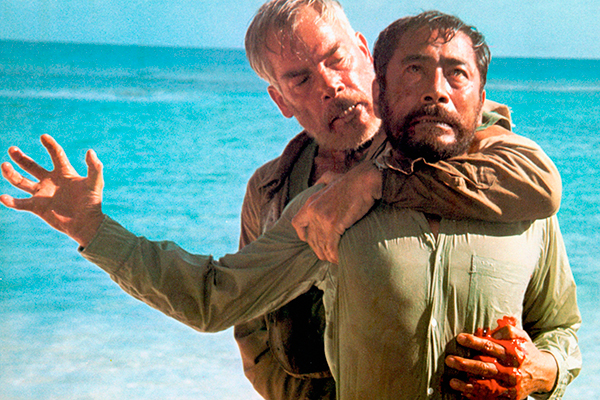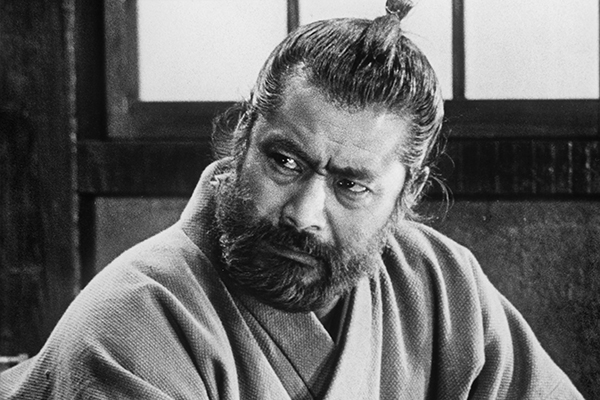Toshiro Mifune,
I am a legend.
PostED ON 13.10.2024
Just as charismatic and impressive as Alain Delon, with whom he starred in Red Sun, Toshiro Mifune, born in 1920, is still the most famous Japanese actor in the world.
 Hell in the Pacific by John Boorman (1968) © Cinerama Releasing Corporation - ABC
Hell in the Pacific by John Boorman (1968) © Cinerama Releasing Corporation - ABC
With his torso perpetually taut, his body movements extra precise and his gaze laser-focused, Mifune always seemed poised for battle. It must be said that his filmography is studded with works of strength, those of perpetually fighting an enemy, be it internal or external. The important thing, it seems, is to be able to surpass oneself.
Thanks to directors who were also ready for anything, Mifune made a series of great films, all of a very different register... Hired at the request of Lee Marvin, an admirer, the Japanese star took on the American actor in John Boorman's Hell in the Pacific. With the exception of Kenji Mizoguchi's The Life of Oharu, in which he fervently struggles to keep his love alive with a woman above his social class, Mifune mainly took on political and social roles. There would be around fifteen such movies under the direction of Akira Kurosawa, many of them influenced by the profound thinking of Feodor Dostoevsky, who created characters fully aware of their fallibility, quick to jump into battle over any subject, and afraid of nothing. For Kurosawa, Mifune transformed into a petty alcoholic criminal in The Drunken Angel, an insatiable doctor in Red Beard, a charismatic fighter in Seven Samurai, and an ambitious businessman in High and Low...

Red Beard by Akira Kurosawa (1961)
When he wasn't shooting with Kurosawa, Mifune’s go-to director was Hiroshi Inagaki. They made over twenty films together, mostly popular romantic melodramas, including The Rickshaw Man and Samurai I: Musashi Miyamoto, where, behind the physical battles fought blow for blow, Mifune portrayed men who ultimately defied convention, discovering courage and the true beauty of following one's destiny, despite his excessively restless nature.
As is so often the case, big actors wanted to take a stab at directing. Mifune took on the role for the first and last time for Legacy of the 500 000. Working behind the camera, he played the leading role, that of a forty-something man working in an office, who is suddenly offered a new job. In reality, he becomes a cog in a gold smuggling operation. Mifune plays the gun-toting adventurer with arresting anguish and dark circles under his eyes in this solid, classic film noir. It was one more role that added to his reputation as the actor of the taut physique and intense gaze.
V.A.
Films presented
Drunken Angel by Akira Kurosawa (Yoidore tenshi, 1948, 1h38)
Rashomon by Akira Kurosawa (1950, 1h28)
The Life of Oharu by Kenji Mizoguchi (Saikaku ichidai onna, 1952, 2h17)
Seven Samurai by Akira Kurosawa (Shichinin no samurai, 1954, 3h27)
Samurai I: Musashi Miyamoto by Hiroshi Inagaki (Miyamoto Musashi, 1954, 1h38)
The Rickshaw Man by Hiroshi Inagaki (Muhomatsu no issho, 1958, 1h44)
Yojimbo by Akira Kurosawa (1961, 1h50)
High and Low by Akira Kurosawa (Tengoku to jigoku, 1963, 2h23)
Red Beard by Akira Kurosawa (Akahige, 1965, 3h05)
Hell in the Pacific by John Boorman (1968, 1h42)
Red Sun by Terence Young (1971, 1h55)
Legacy of the 500,000 by Toshiro Mifune (Gojuman-nin no isan, 1963, 1h38)

